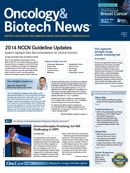Publication
Article
Oncology & Biotech News
Chemotherapy Underutilized in High-Risk Bladder Cancer
Author(s):
Despite evidence supporting its efficacy, chemotherapy is not routinely administered to patients with muscle-invasive bladder cancer.
Christopher Booth, MD
Despite evidence supporting its efficacy, chemotherapy is not routinely administered to patients with muscle-invasive bladder cancer (MIBC), according to a population-based outcomes study from Canadian researchers.
“Patients having surgery for bladder cancer should have chemotherapy, either before or after surgery. Efforts are needed to improve uptake of this treatment, which appears to be vastly underutilized,” lead author Christopher Booth, MD, Division of Cancer Care and Epidemiology, Queen’s University Cancer Research Institute, Ontario, Canada, said in a statement.
Research supports the use of neoadjuvant chemotherapy (NACT) in MIBC, including a metaanalysis of randomized controlled trials that found a significant 5% overall survival benefit with NACT (Eur Urol. 2005;48[2]:202-205). Although the efficacy of adjuvant chemotherapy (ACT) is not as firmly established in the literature, the authors wrote, “the clinical community appears to have accepted the efficacy of ACT.”
Booth et al sought to determine the use and efficacy of perioperative chemotherapy among the general population of Ontario. They evaluated records of 2944 patients with MIBC from the Ontario Cancer Registry who received a cystectomy between 1994 and 2008. The majority of patients had locally advanced (T3/T4) tumors (71%), were male (75%), and were aged >70 years (60%). Positive lymph nodes were reported in one-fourth of cases.
Overall, NACT was administered to 4% of patients (n = 129), 19% received ACT (n = 572), and 1% (n = 30) were treated with both. To examine usage trends, the researchers segmented patients into three groups: 1994- 1998 (n = 705), 1999-2003 (n = 964), and 2004-2008 (n = 1275). NACT use remained static across the three intervals at 5%, 3%, and 6%, respectively, while use of chemotherapy after cystectomy increased from 16%, to 18%, to 22%.
The researchers were able to identify the specific regimen for 46% (n = 308) of the patients who received perioperative chemotherapy. Among this group, treatment included cisplatin in 82% of patients and carboplatin in 14%. Adjusted analyses linked younger age to increased use of chemotherapy in general and poor pathology with higher ACT use.
The 5-year overall survival (OS) rate for the study population as a whole was 29% (95% CI, 28-31), with a cancer-specific survival (CSS) rate of 33% (95% CI, 31-35). Patients receiving chemotherapy before surgery had a 5-year OS of 25% (95% CI, 17-34) and a 5-year CSS of 28% (95% CI, 18-39). The corresponding rates for the adjuvant group were 29% (95% CI, 25-33) and 28% (95% CI, 24-33), respectively.
Adjusted analyses of ACT use in the general population showed a hazard ratio of 0.71 for OS (95% CI, 0.62-0.81) and 0.73 for CSS (95% CI, 0.64-0.84). “Results from our study demonstrate that chemotherapy given after surgery improves patient survival—probably on the same order of magnitude as chemotherapy before surgery,” Booth said.
The authors noted that the 5-year OS rates of 25% and 29% for NACT and ACT, respectively, were “substantially” lower than rates reported in previous studies. With NACT, a 5-year OS rate of 57% was reported in a phase III randomized trial (N Engl J Med. 2003;349:859-866). Likewise, an updated meta-analysis showed a 5-year OS with ACT of about 50% (Eur Urol. 2005;48[2]:189- 199). Possible explanations for these OS discrepancies, according to the authors, are varying surgical strategies, biases in patient selection/referral, and the “known association between greater cystectomy volumes and improved outcomes.”
In their conclusion, Booth et al wrote, “Given the potential for perioperative chemotherapy to improve patient outcomes, further efforts are needed to understand reasons for underutilization.”
Booth CM, Siemens DR, Li G, et al. Perioperative chemotherapy for muscle-invasive bladder cancer: a population-based outcomes study [published online April 14, 2014]. Cancer. doi:10.1002/ cncr.28510.










